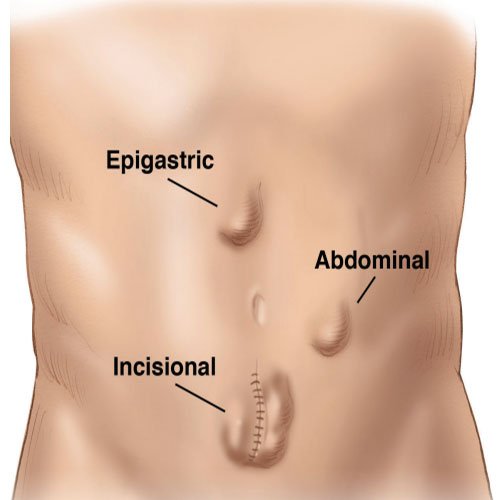Ventral Hernia
A ventral hernia is a condition that occurs when an internal organ, often the intestines, protrudes through a weak spot in the abdominal wall. This type of hernia typically develops in the abdominal area and can occur due to various factors, including:
- Weakness in the abdominal wall: This may be congenital (present at birth) or acquired due to previous surgeries, trauma, or aging.
- Increased abdominal pressure: Activities or conditions that increase pressure in the abdomen, such as heavy lifting, obesity, pregnancy, chronic coughing, or straining during bowel movements, can contribute to hernia formation.

Symptoms
The symptoms of a ventral hernia can vary, but common signs include:
- A noticeable bulge or swelling in the abdomen that may become more prominent when standing or straining
- Discomfort or pain at the site of the hernia, especially when lifting or bending
- A feeling of heaviness in the abdomen
- Nausea or vomiting in cases where the hernia leads to bowel obstruction
Types of Ventral Hernias
Ventral hernias are classified into several types, including:
- Umbilical Hernia: Occurs at the belly button (umbilicus) and is common in infants and adults.
- Incisional Hernia: Develops at the site of a previous surgical incision in the abdominal wall.
- Epigastric Hernia: Occurs in the upper midline of the abdomen, often containing fatty tissue.
- Spigelian Hernia: Forms through the Spigelian fascia, located on the lateral abdominal wall.
Diagnosis
Diagnosis of a ventral hernia typically involves:
- Physical Examination: A healthcare provider will examine the abdomen for swelling or tenderness and ask about symptoms.
- Imaging Tests: Ultrasound, CT scans, or MRI may be used to confirm the diagnosis and assess the size and contents of the hernia.
Treatment
Treatment options for ventral hernias may vary based on the severity of the hernia, symptoms, and overall health of the patient. Options include:
Watchful Waiting: If the hernia is small and asymptomatic, monitoring the condition may be recommended, particularly in elderly patients or those with other health issues.
Surgical Repair: Surgery is the most common treatment for ventral hernias, especially if they are painful or larger. Surgical options include:
- Open Surgery: The surgeon makes a large incision to access the hernia, push the protruding organ back into place, and repair the abdominal wall, often using mesh to reinforce the area.
- Laparoscopic Surgery: A minimally invasive procedure where small incisions are made, and the surgeon uses a camera and specialized instruments to repair the hernia. This method generally results in less pain and quicker recovery compared to open surgery.
Lifestyle Changes: Maintaining a healthy weight, avoiding heavy lifting, and managing conditions like chronic cough or constipation can help prevent the development or worsening of a hernia.





